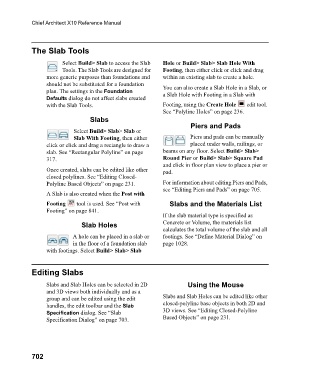Page 702 - Chief Architect Reference Manual
P. 702
Chief Architect X10 Reference Manual
The Slab Tools
Select Build> Slab to access the Slab Hole or Build> Slab> Slab Hole With
Tools. The Slab Tools are designed for Footing, then either click or click and drag
more generic purposes than foundations and within an existing slab to create a hole.
should not be substituted for a foundation You can also create a Slab Hole in a Slab, or
plan. The settings in the Foundation a Slab Hole with Footing in a Slab with
Defaults dialog do not affect slabs created
with the Slab Tools. Footing, using the Create Hole edit tool.
See “Polyline Holes” on page 236.
Slabs
Piers and Pads
Select Build> Slab> Slab or
Slab With Footing, then either Piers and pads can be manually
click or click and drag a rectangle to draw a placed under walls, railings, or
slab. See “Rectangular Polyline” on page beams on any floor. Select Build> Slab>
317. Round Pier or Build> Slab> Square Pad
and click in floor plan view to place a pier or
Once created, slabs can be edited like other pad.
closed polylines. See “Editing Closed-
Polyline Based Objects” on page 231. For information about editing Piers and Pads,
see “Editing Piers and Pads” on page 705.
A Slab is also created when the Post with
Footing tool is used. See “Post with Slabs and the Materials List
Footing” on page 841.
If the slab material type is specified as
Slab Holes Concrete or Volume, the materials list
calculates the total volume of the slab and all
A hole can be placed in a slab or footings. See “Define Material Dialog” on
in the floor of a foundation slab page 1028.
with footings. Select Build> Slab> Slab
Editing Slabs
Slabs and Slab Holes can be selected in 2D Using the Mouse
and 3D views both individually and as a
group and can be edited using the edit Slabs and Slab Holes can be edited like other
handles, the edit toolbar and the Slab closed-polyline base objects in both 2D and
Specification dialog. See “Slab 3D views. See “Editing Closed-Polyline
Specification Dialog” on page 703. Based Objects” on page 231.
702

